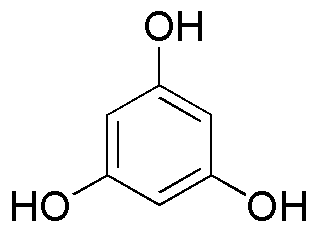Phloroglucinol (anhydrous) is widely utilized in research focused on:
- Pharmaceutical Development: It serves as a key ingredient in medications for gastrointestinal disorders, providing relief from spasms and pain.
- Analytical Chemistry: Used as a reagent in various analytical techniques, it helps in the detection and quantification of certain compounds, enhancing accuracy in research labs.
- Food Industry: Acts as a flavoring agent and preservative, contributing to the stability and taste of certain food products.
- Cosmetic Formulations: Incorporated into skincare products for its antioxidant properties, improving skin health and appearance.
- Research in Plant Biology: Utilized in studies to understand plant responses to stress, aiding in the development of more resilient crop varieties.
General Information
Properties
Safety and Regulations
Applications
Phloroglucinol (anhydrous) is widely utilized in research focused on:
- Pharmaceutical Development: It serves as a key ingredient in medications for gastrointestinal disorders, providing relief from spasms and pain.
- Analytical Chemistry: Used as a reagent in various analytical techniques, it helps in the detection and quantification of certain compounds, enhancing accuracy in research labs.
- Food Industry: Acts as a flavoring agent and preservative, contributing to the stability and taste of certain food products.
- Cosmetic Formulations: Incorporated into skincare products for its antioxidant properties, improving skin health and appearance.
- Research in Plant Biology: Utilized in studies to understand plant responses to stress, aiding in the development of more resilient crop varieties.
Documents
Safety Data Sheets (SDS)
The SDS provides comprehensive safety information on handling, storage, and disposal of the product.
Product Specification (PS)
The PS provides a comprehensive breakdown of the product’s properties, including chemical composition, physical state, purity, and storage requirements. It also details acceptable quality ranges and the product's intended applications.
Certificates of Analysis (COA)
Search for Certificates of Analysis (COA) by entering the products Lot Number. Lot and Batch Numbers can be found on a product’s label following the words ‘Lot’ or ‘Batch’.
*Catalog Number
*Lot Number
Certificates Of Origin (COO)
This COO confirms the country where the product was manufactured, and also details the materials and components used in it and whether it is derived from natural, synthetic, or other specific sources. This certificate may be required for customs, trade, and regulatory compliance.
*Catalog Number
*Lot Number
Safety Data Sheets (SDS)
The SDS provides comprehensive safety information on handling, storage, and disposal of the product.
DownloadProduct Specification (PS)
The PS provides a comprehensive breakdown of the product’s properties, including chemical composition, physical state, purity, and storage requirements. It also details acceptable quality ranges and the product's intended applications.
DownloadCertificates of Analysis (COA)
Search for Certificates of Analysis (COA) by entering the products Lot Number. Lot and Batch Numbers can be found on a product’s label following the words ‘Lot’ or ‘Batch’.
*Catalog Number
*Lot Number
Certificates Of Origin (COO)
This COO confirms the country where the product was manufactured, and also details the materials and components used in it and whether it is derived from natural, synthetic, or other specific sources. This certificate may be required for customs, trade, and regulatory compliance.


